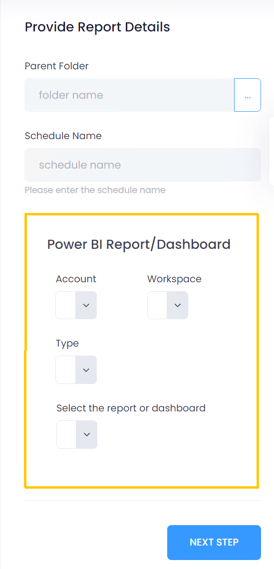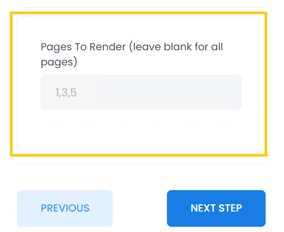How do I create a Single Data-Driven Power BI schedule in the PBRS Web Application?
This article will provide a step-by-step guide to building and deploying a Single Data-Driven Power BI schedule in the PBRS Web Application.
Step 1
To create a new schedule for a Single Data-Driven Power BI Report in the Web Application, begin by selecting the "New schedule" drop-down menu. From there, choose the option for "Data-Driven Power BI Report Schedule".

You will then see the Scheduling Screen where you can configure the schedule settings.
Step 2
General Tab: In the "Provide Report Details" section, click on the (...) option and select your Parent Folder from the list provided and give the Schedule a Name to easily identify it.

Step 3
In the "Power BI Report / Dashboard" Section
- Choose the required the Power BI account needed to access the Power BI report that you want to Schedule.
- Select the required workspace from the Workspace drop-down menu.
- Select the Type of report that you want to Schedule from the Type drop-down menu.
- Choose the Report or Dashboard that you want to schedule.

Step 4
Proceed to the Data-Driver tab by clicking the "Next Step" button.
In the Data-Driver tab
- Select your DSN.
-Enter your User ID & Password.
-Enter your Query.
When you have entered all of this information in, select Validate Query.

A pop up will appear stating whether or not the query validated successfully. Click OK.
Step 5
The Key Column box will now appear for you to select the Key Column.

Step 6
Proceed to the Scheduling Tab by clicking the "Next Step" button.

In the "Setup when the schedule should run" section, you can select the start date for your schedule by clicking on the calendar icon. Choose the specific date when you want the schedule to begin running.
-Set the Frequency for the schedule, whether it's daily, weekly, or monthly. This frequency setting determines how often the schedule will run.
-Select a Schedule Time for when the schedule should execute. If you need this schedule to repeat multiple times throughout the day, you can select the "Repeat Every" option.
-Check Enable this Schedule, to ensure that the schedule will run when it is supposed to in the future.
Step 7
Proceed to the Report Settings Tab by clicking the "Next Step" button.

In the Report Rendering Settings section, you have the flexibility to customize and apply specific settings to the report according to your preferences.
-If you prefer not to export all pages of the report, you have the option to specify which pages you want to export in this section.
Step 8
Proceed to the Filters Tab by clicking the "Next Step" button.

To add a Report Filter, click on the "Add Filter" button. The following screen will be displayed.

Configure the required report filters.
-Under Filter using this Field, enter your report filter.
-You can select your data type under the Field Data Types drop down button.
-Select whether or not you would like your Filter Type to be basic or advanced and enter your required filter.
Add Data-Driven filters by clicking on the Inserts button.

Click Add to add the filter then click on the Save button to save the Report Filters and close this screen.
Step 9
Proceed to the Destinations tab by clicking the "Next Step" button.

In the Destinations Section, click Add Destination to add a destination for the report. The following Screen will be displayed.

Provide a Destination Name, choose between Email or Disk Destination, and select the desired Output Format.

You also have the option to incorporate Data-Driven filters into the body of the destination.

Save your destination by clicking on the "Save" button to close the screen.
Step 10
Proceed to the Completed Tab by clicking the "Next Step" button.

After reviewing the schedule setup and confirming that no changes are needed, simply click on the Submit button to save the schedule.
Once the Schedule has been created the following screen will be displayed.

You have now created a Data-Driven Power BI schedule in the PBRS Web Application.

